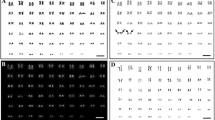Abstract
The somatic karyotypes of 10 taxa belonging toAllium subgen.Molium (Liliaceae) from the Mediterranean area have been investigated using Giemsa C-band and fluorochrome (Hoechst, Quinacrine) banding techniques. A wide range of banding patterns has been revealed. InAllium moly (2n = 14),A. oreophilum (2n = 16) andA. paradoxum (2n = 16) C-banding is restricted to a region on each side of the nucleolar organisers and the satellites show reduced fluorescence with fluorochromes. The satellites are also C-banded and with reduced fluorescence inA. triquetrum (2n = 18), but two other chromosome pairs also have telomeric bands which are not distinguished by fluorochrome treatment. InA. erdelii (2n = 16) 4 pairs of metacentric chromosomes have telomeric C-bands while 2 pairs of telocentric chromosomes have centromeric C-banding. InA. subhirsutum (2n = 14),A. neapolitanum (2n = 28),A. trifoliatum subsp.hirsutum (2n = 14) andA. trifoliatum subsp.trifoliatum (2n = 21) chromosomes with long centromeres, consisting of a centromere and nucleolar organiser are positively C-banded on each side of the constriction. InA. subhirsutum banding is confined to the pair of chromosomes with this feature, whereas inA. neapolitanum one additional chromosome pair has telomeric bands and inA. trifoliatum there are varying numbers of chromosomes with centromeric and telomeric bands, depending on the subspecies.A. zebdanense (2n = 18) shows no C-bands. The banding patterns in this subgenus are compared with those recorded for otherAllium species and with the sectional divisions in the genus. Evidence from the banding patterns for allopolyploidy inA. trifoliatum subsp.trifoliatum andA. neapolitanum is discussed.
Similar content being viewed by others
References
Barling, D. M., 1958: Reproduction and cytology ofAllium paradoxum. Proc. Bot. Soc. Br. Isl.3, 85.
Boissier, E., 1882:Allium. In: Flora Orientalis5, 229–285. Genevae et Basileae: H. Georg.
Eid, S. E., 1963: Cytological studies in sectionMolium of the genusAllium. Genetics Today1, 134.
— 1964: Evolution inAllium erdelii andAllium roseum varieties. Xth Int. Bot. Congr. Edinburgh, Abstr. 364.
Ekberg, L., 1969: Studies in the genusAllium, II. A new subgenus and new species from Asia. Bot. Notiser122, 57–68.
El-Gadi, A., Elkington, T. T., 1975: Comparisons of the Giemsa C-band karyotypes and relationships ofAllium cepa, A. fistulosum andA. galanthum. Chromosoma51, 19–23.
Feinbrun, D., 1950: Chromosome counts in PalestinianAllium species. Palest. J. Bot. Jerusalem Ser.5, 13–16.
Fiskesjö, G., 1975: Chromosomal relationships between three species ofAllium as revealed by C-banding. Hereditas81, 23–31.
Greilhuber, J., Speta, F. (1976): C-banded karyotypes in theScilla hohenackeri group,S. persica, andPuschkinia (Liliaceae). Plant Syst. Evol.126: 149–188.
Hattersley-Smith, M. K., 1956:Allium neapolitanum: a mixed species. Nature178, 272.
Hsu, T. C., 1973: Longitudinal differentiation of chromosomes. A. Rev. Genet.7, 153–176.
Jalal, S. M., Clark, R. W., Hsu, T. C., Pathak, S., 1974: Cytological Differentiation of Constitutive Heterochromatin. Chromosoma48, 391–403.
Kollmann, F., 1969: Cytotaxonomic polymorphism in theAllium erdelii group. Israel J. Bot.18, 61–75.
—, 1970: Karyotypes of threeAllium species of theerdelii group. Caryologia23, 647–655.
—, 1973: Caryology of some species ofAllium sectionMolium. Israel J. Bot.22, 92–112.
—, 1975: Note:Allium trifoliatum subsp.hirsutum. Israel J. Bot.24, 201–204.
Kurita, M., 1956: Karyotypes of some species inAllium. Mem. Ehim Univ. Sect. II2, 11–17.
Levan, A., 1931: Cytological Studies inAllium: A Preliminary Note. Hereditas15, 347–356.
—, 1932: Cytological Studies inAllium: II. Chromosome Morphological Contribution. Hereditas16, 257–294.
—, 1935: Cytological Studies inAllium: IV. The Chromosome Morphology of some diploid species ofAllium. Hereditas20, 289–330.
Marks, G. E., Schweizer, D., 1974: Giemsa Banding: Karyotype Differences in some species ofAnemone and inHepatica nobilis. Chromosoma44, 405–416.
Martinoli, G., 1955: Cariologia di alcune specie del genereAllium (Liliaceae) della Sardegna Caryologia7, 145–156.
Pederson, K., Wendelbo, P., 1966: Chromosome number of some S. W. AsianAllium species. Blyttia24, 307–313.
Regel, E., 1875:Alliorum adhuc cognitorum monographia. Acta Horti Petrop.3, 1–266.
Schweizer, D., Ehrendorfer, F., 1976: Giemsa banded karyotypes, systematics, and evolution inAnacyclus (Asteraceae-Anthemideae). Plant Syst. Evol.126, 107–148.
Stack, S. M., Clarke, C. R., 1973: Differential Giemsa staining of the telomeres ofAllium cepa chromosomes. Observations related to chromosome pairing. Can. J. Genet. Cytol.15, 619–624.
Stearn, W. T., 1946: Notes on the genusAllium in the old world. Herbertia (La Jolla)11, 11–34.
Vakhtina, L. J., 1964: Chromosome number of some species ofAllium wide-spread in U.S.S.R. Bot. Ž. (SSSR)49, 870–875.
—, 1969: A comparative karyological investigation of some species ofAllium L. (Liliaceae) belonging to the sectionMolium. Bot. Ž. (SSSR)54, 143–150.
Ved Brat, S., 1965: Genetic systems inAllium: I. chromosome variation. Chromosoma16, 486–499.
Vosa, C. G., 1970: Heterochromatin recognition with fluorochromes. Chromosoma30, 366–372.
—, 1971: The quinacrine fluorescence patterns of the chromosomes ofAllium carinatum. Chromosoma33, 382–385.
—, 1973: The enhanced and reduced fluorescence bands and their relationship to the Giemsa patterns inAllium flavum. Nobel Symposium23, 156–158.
—, 1974: The basic karyotype of rye (Secale cereale) analyzed with Giemsa and fluorescence methods. Heredity33, 403–408.
—, 1975: The use of Giemsa and other staining techniques in karyotype analysis. Curr. Adv. Plant Sci.14, 495–510.
—, 1976a: Heterochromatic patterns inAllium: I. The relationship between the species of thecepa group and its allies. Heredity36, 383–392.
—, 1976b: Heterochromatic patterns inAllium: II. Heterochromatin variation in species of thepaniculatum group. Chromosoma57, 119–133.
Wendelbo, P., 1971:Alliaceae. InRechinger, K. H. (Ed.): Flora Iranica76. Graz: Akademische Druck- und Verlagsanstalt.
Author information
Authors and Affiliations
Rights and permissions
About this article
Cite this article
Badr, A., Elkington, T.T. Variation of Giemsa C-band and fluorochrome banded karyotypes, and relationships inAllium subgen.Molium . Pl Syst Evol 128, 23–35 (1977). https://doi.org/10.1007/BF00985168
Received:
Issue Date:
DOI: https://doi.org/10.1007/BF00985168




